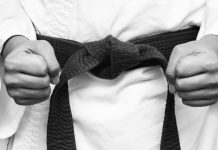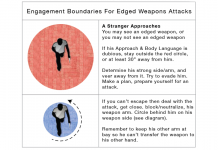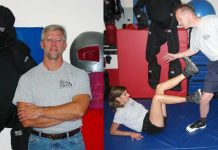Cross-training isn’t a new concept. The Shaolin and the Samurai both cross-trained … and they weren’t the only ones, just the best known. Cross-training has been around for a long time … probably as long as martial arts. It’s just that in this day and age, we have a larger variety of options available for cross-training.
There are no “pure” martial arts. Every system of martial arts has been influenced by other systems. Either directly or indirectly. When fighters fight, they influence each other … it’s inevitable. Since martial arts wouldn’t exist without confrontation, all the martial arts systems have been influenced by each other (or by now defunct systems). Where they didn’t directly “steal” from each other, they developed things specifically to counter each other.
Cross-training isn’t a new concept. The Shaolin and the Samurai both cross-trained … and they weren’t the only ones, just the best known. Cross-training has been around for a long time … probably as long as martial arts. It’s just that in this day and age, we have a larger variety of options available for cross-training.
There are some universal pros and cons to cross-training. But on top of these, each person will have his/her own personal pros and cons when it comes to cross-training. Some people are wired in such a way that they would just be spinning their wheels if they tried to cross-train. Others are wired such that they’d get bored and quit if they couldn’t change gears every so often.
Cross-training can be very valuable … if done properly. A “foundation” is vital. The foundation gives a student a certain base-line understanding and something with which to anchor future learning. The foundation can be developed alongside supplemental training … but the training must be perceived as such (i.e.: a foundation and supplements).
Once the foundation is solid and the basic principles are understood, then the student can start spotting those principles in other training. The principles are universal. Every martial art draws from the same large pool of concepts and principles. What makes each system unique is the emphasis it places on various aspects and the approach it takes in applying the various concepts and principles.
So, once the basic principles are understood, it’s useful to see how other arts, systems, styles, or instructors approach those same principles. Where an art overlaps one’s foundation, depth is gained. Where it doesn’t overlap, breadth is gained.
But without the foundation, you’re just digging a bunch of shallow holes and will likely never hit water.
Dig until you hit water … then you can start looking for other flavors of water.
I think it is possible for a person to develop a core while simultaneously training in supplemental material. But, for most, I don’t think this is the most efficient approach to training. Until the student has a foundation, all they are really doing is collecting techniques. The foundation, an understanding of the underlying concepts and principles, is what ties all the various techniques together. “Technique collection” is one of the universal pitfalls of cross-training. Like any pitfall, though, if one is aware of it, it can be avoided.
In which system the foundation is developed is irrelevant. What matters is that the student develops and understanding of the underlying principles and an eye for spotting them. The student should reach a point where he/she understands the underlying principles and can answer the question, “Why does this technique work?” Once that understanding is developed, the student should have the mindset of seeking the principles and a foundation for recognizing/comprehending them.
Each student starts as a mimic. He/she mimics the instructor to learn the basic movements. Later, the student mimics the instructor’s explanation of the movements. At some point, though, the student should start understanding the movements. The explanation may or may not change, but the understanding should change. The student should reach a point where he/she can explain the same movement in a variety of ways that branch from that understanding. Without the understanding, the student can never do more than parrot the instructor’s words.
If a student seeks only to learn how to fight, then cross-training isn’t necessary … though it may still be helpful. I think martial artists, though, should seek out other perspectives in order to deepen their own understanding. A martial artist should always be in pursuit of developing a better answer to the question, “Why does this work?”
Students must learn to seek the underlying principles … not techniques. If you learn one technique, then all you have is one technique. If you learn the underlying principle behind that technique, then you have a thousand techniques. This is analogous to, “Give a man a fish and feed him for a day. Teach a man to fish and feed him for a lifetime.” If a student never digs deeper than the techniques, then the student will become a “technique collector.” He/she will have a bunch of pretty techniques but no real understanding of why they work or how they might be tied together. To return to the fishing analogy, this would be like collecting a bunch of fish instead of learning to fish. That collection of fish, no matter how large, will only feed the person for a few days before the fish start to rot.
Here’s specific martial arts example (from my own experience) of this concept:
In the Silat that I study, we have “kunci jembatan” … literally, “locking the bridge.” Technically, this term can be applied to virtually any joint lock done to the extremities. But we have a few specific locks that we apply it to. One of these locks is identical to Aikido’s “shiho nage.” Silat and Aikido get to the lock (or throw, depending on how it’s done) in different ways. If I just learn these techniques then all I’ll have is a couple of ways of getting to the same lock.
But, because of my solid foundation in Silat, I understand that the principle of that lock is used in several other locks (which also fall under the heading of “kunci jembatan” in Silat). Since I understood this, when I learned “shiho nage,” I automatically realized that the “shiho nage” and “kunci jembatan” were working with the same principle. Therefore, I wound up with literally dozens of “techniques” based on that shared principle … and I wound up with quite a number of ways to get to those techniques.
Since they are based on principles that I know are valid, each of these dozens of techniques is also valid. Though the practicality of each, for me, will depend on my testing of each. But I know that each one is valid because it is firmly rooted in a valid principle.
So, a “technique collector” would come away with two techniques. A martial artist comes away with dozens.
Cross-training shouldn’t be about learning how to fight. It should be about refining the knowledge of how to fight. “Technique collectors” aren’t refining, they’re loading up. Eventually, they’ll overload. Proper cross-training should be about refinement. It should be about finding options within what you already know … not about adding new “techniques” to the pile.
A potential problem with cross-training from the beginning is that all of the student’s classes will be beginner’s classes. If one studies 5 arts for 1 year, he/she will only have one year of training. The student will still only be a novice in each of those arts and in his/her overall development. If the student then starts switching and studying other arts, he/she will never be taught anything past the rudimentary basics. Some people can train in several things simultaneously and, intuitively, find the underlying connections between the arts. For most, though, this approach is the long way around.
For most people, the most efficient route to building a foundation is to train in one system until the foundation is built. Once the foundation is built, then cross-training can be useful in finding weak areas in the foundation and shoring them up and in building a house on that foundation.
It’s a fine line to walk. Cross-training is easy. Proper cross-training is difficult. But if one can walk that line, they are likely, though not guaranteed, to be better martial artists because of it.
On the flip-side, cross-training isn’t necessary. It’s possible to be a good martial artist and to develop a solid foundation and understanding of the underlying principles without cross-training. For people who can’t walk that fine line and find proper cross-training, though … they’re better off not cross-training at all.






